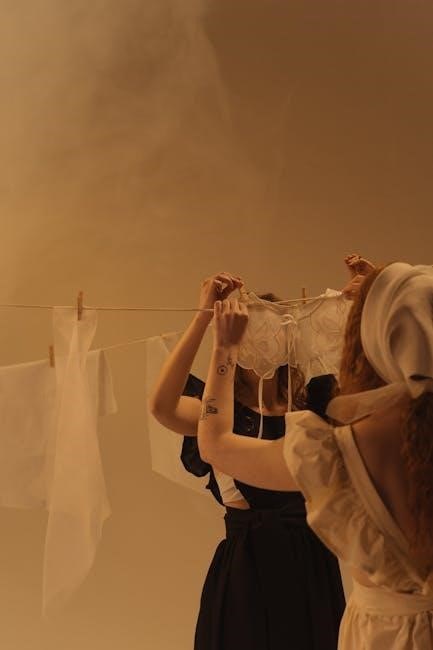Intimate Apparel, a play by Lynn Nottage, explores the life of Esther, a Black seamstress in 1905 New York City, creating delicate lingerie for diverse clients. The story delves into themes of loneliness, empowerment, and racial challenges, offering a poignant portrayal of resilience and human connection. Available as a PDF, the play is a critical acclaim, shedding light on women’s lives and historical struggles.
Overview of the Play
Intimate Apparel, written by Lynn Nottage, is a poignant drama set in 1905 New York City. The play centers on Esther Mills, a skilled African American seamstress who creates exquisite lingerie for clients ranging from wealthy white women to prostitutes. Despite her success, Esther’s life is marked by loneliness and a deep longing for love and marriage. Through a pen-pal relationship with George, a Caribbean laborer working on the Panama Canal, Esther’s desires and vulnerabilities are revealed. The play explores themes of empowerment, racial disparities, and the resilience of women in a society governed by strict social norms. Nottage’s masterful storytelling weaves together historical context and personal struggle, offering a powerful portrait of Esther’s journey toward self-discovery and hope. The play is available in PDF format for readers to explore its rich narrative and emotional depth.
Historical Context of 1905 New York City
In 1905 New York City, the setting of Intimate Apparel, the city was a hub of immigration, industrialization, and social change. The early 20th century marked a period of rapid urbanization, with people from diverse backgrounds flocking to the city for opportunities. For African Americans like Esther Mills, life was fraught with racial segregation and limited prospects. The play highlights the stark contrast between the opulence of Fifth Avenue and the struggles of working-class individuals. Additionally, the construction of the Panama Canal, a major historical event, looms in the background, connecting characters like George to global endeavors. This era of transformation and inequality provides the backdrop for Esther’s journey, emphasizing the resilience required to navigate societal constraints. The play vividly captures the complexities of life in early 20th-century New York.

Main Characters and Their Roles
Esther Mills, a skilled African American seamstress, is the protagonist, creating intimate apparel for diverse clients while longing for love and connection. Mrs. Dickson, her wise landlady, offers guidance, and Mr. George, a mysterious suitor, brings unexpected hope into Esther’s life, shaping her journey.
Esther Mills: The African American Seamstress
Esther Mills, the protagonist of Intimate Apparel, is a 35-year-old African American seamstress living in Lower Manhattan during 1905. Her exceptional talent for creating exquisite lingerie earns her a reputation among wealthy white clients and prostitutes alike. Despite her financial independence, Esther’s life is marked by deep loneliness and a longing for love and marriage. Through her craft, she pours her heart into every stitch, reflecting her own desires for connection and a future beyond her modest existence. Esther’s story is a testament to resilience and the challenges faced by Black women in a society dominated by racial and gender barriers. Her journey explores themes of empowerment, loneliness, and the pursuit of happiness in a restrictive world.
Mrs. Dickson: The Landlady
Mrs. Dickson, the African American landlady of a boarding house for women, plays a pivotal role in Esther’s life. She is a strong, sharp-tongued figure who enforces strict rules to protect her tenants, reflecting her practical wisdom. While her demeanor is often firm, she cares deeply for Esther, offering guidance and support. Mrs. Dickson’s character represents the resilience and resourcefulness of Black women in 1905 New York, navigating societal challenges while maintaining a sense of community. Her interactions with Esther highlight the tension between independence and tradition, as she advises caution in matters of love and marriage. Mrs. Dickson’s presence underscores the realities of women’s lives during this era, blending authority with empathy. Her role is both protective and pivotal, shaping Esther’s journey in subtle yet profound ways.
Mr. George: Esther’s Mysterious Suitor
Mr. George, a Caribbean laborer working on the Panama Canal, enters Esther’s life through a correspondence initiated by a mutual acquaintance. Their relationship, conducted primarily through letters, sparks hope and longing in Esther, who yearns for love and companionship. Despite the distance and societal barriers, George’s charming and thoughtful letters create a deep emotional connection with Esther. However, his true nature and intentions remain shrouded in mystery, leaving Esther to navigate the complexities of trust and vulnerability. Their relationship serves as a central plot device, exploring themes of isolation, desire, and the challenges of building intimacy across vast distances. Mr. George’s presence in Esther’s life becomes a turning point, influencing her journey toward self-discovery and resilience. His enigmatic character adds layers to the narrative, highlighting the fragility and beauty of human connection.

Themes Explored in Intimate Apparel
Intimate Apparel delves into themes of loneliness, empowerment through work, and racial challenges, portraying Esther’s journey as a Black seamstress in 1905 New York City.
Loneliness and Longing
Esther, a skilled African American seamstress in 1905 New York, creates exquisite lingerie for clients while yearning for love and connection. Her loneliness is profound, as she remains unmarried and isolated, despite her professional success. The play poignantly captures her deep longing for a husband and a future, highlighting the emotional toll of her solitary life. Through her correspondence with George, a mysterious suitor, Esther’s vulnerability and desire for companionship are revealed, showcasing the universal human need for intimacy and understanding. This theme resonates deeply, illustrating the stark contrast between her fulfilling work and her unfulfilled personal life.
Empowerment Through Work
Esther’s profession as a seamstress in 1905 New York City serves as a source of empowerment, allowing her to navigate a society dominated by racial and gender barriers. Through her exceptional skill in creating intimate apparel, she gains financial independence and respect from her diverse clientele, ranging from wealthy white socialites to sex workers. Esther’s work not only provides her with a sense of purpose but also challenges societal norms, as she builds a reputation for her craftsmanship. Her ability to support herself and thrive in a male-dominated world underscores her resilience and determination. The play highlights how Esther’s work becomes a form of self-expression and autonomy, offering her a path to dignity and self-worth in a world that often marginalizes her identity.
Racial and Social Challenges

Esther faces significant racial and social challenges as a Black seamstress in 1905 New York City. Despite her talent, she encounters systemic racism and limited opportunities, reflecting the era’s entrenched prejudices. Her correspondence with George, a Caribbean laborer on the Panama Canal, highlights the struggles faced by Black individuals in a segregated world. The play underscores the harsh realities of racial discrimination, as Esther navigates a society that often devalues her contributions. Additionally, the societal norms of the time restrict her personal and professional aspirations, making her journey towards independence and love even more arduous. These challenges serve as a backdrop to Esther’s resilience and determination to carve out a fulfilling life amidst adversity.
Production and Reception
Intimate Apparel was a co-production between Center Stage and South Coast Repertory, directed by Dr. Jaye Austin Williams. It received critical acclaim, earning top prizes from major critics and showcasing Nottage’s masterful storytelling, resonating deeply with audiences.
Original Production Details
Intimate Apparel was first produced in 2003 as a co-production between Center Stage in Baltimore and South Coast Repertory in Costa Mesa, California. Directed by Dr. Jaye Austin Williams, the play premiered to great acclaim, marking a significant milestone in Lynn Nottage’s career. The original production showcased a talented cast and crew, bringing to life the intricate story of Esther Mills, a Black seamstress in 1905 New York. The play’s setting and costumes were meticulously designed to reflect the era, highlighting the craftsmanship of Esther’s work and the societal context of her life. This original production laid the foundation for the play’s widespread success and recognition in the theatrical world.
Critical Acclaim and Awards
Intimate Apparel received widespread critical acclaim for its powerful storytelling and nuanced character development. The play earned Lynn Nottage numerous accolades, solidifying her reputation as a leading voice in contemporary theater. It won top prizes from three major critics’ groups in New York, further cementing its impact. Nottage’s work was praised for its ability to illuminate the challenges faced by women during pivotal moments in history. The play’s success led to its recognition as a landmark production, with many considering it a masterpiece of modern drama. Its thoughtful exploration of themes such as loneliness, empowerment, and racial challenges resonated deeply with audiences and critics alike, ensuring its place in theatrical history.
Notable Performances and Reviews
Intimate Apparel has been praised for its exceptional performances across various productions. The play’s debut at the Mark Taper Forum was met with critical acclaim, with reviewers highlighting the emotional depth and authenticity brought by the cast. Esther’s character, portrayed by talented actresses, has been particularly noted for her complexity and relatability. The play’s ability to connect with audiences has been a consistent theme in reviews, with many praising its raw honesty and emotional resonance. Performances in regional theaters, such as the Carlsbad New Village Arts Theatre, have also garnered positive feedback, underscoring the timeless relevance of the story. The play’s success lies in its ability to weave together powerful narratives with stellar acting, creating an unforgettable theatrical experience.
Social and Cultural Impact
Intimate Apparel sheds light on the lives of women in 1905 New York, particularly African American women, highlighting racial and gender challenges while celebrating resilience and empowerment. The play’s portrayal of Esther’s journey resonates with contemporary discussions on identity, inequality, and social justice, making it a significant cultural touchstone.
Portrayal of Women’s Lives
Intimate Apparel offers a profound portrayal of women’s lives in early 20th-century New York, particularly focusing on Esther, a Black seamstress. The play highlights her strength and resilience as she navigates a society fraught with racial and gender barriers. Esther’s craft as a creator of intimate apparel symbolizes her independence and skill, yet her personal life remains marked by loneliness and longing. Through her story, Lynn Nottage sheds light on the challenges faced by women, especially African American women, during this period. The play underscores the societal constraints and limited opportunities while celebrating the resilience and determination of women in the face of adversity. This portrayal remains deeply relevant, resonating with contemporary discussions on gender and race.
Historical Relevance

Intimate Apparel is deeply rooted in the historical context of 1905 New York City, offering insights into the social and racial dynamics of the era. The play highlights the challenges faced by African Americans, particularly women, during this period. Esther’s journey as a seamstress reflects the limited opportunities and societal constraints imposed on Black women. The mention of the Panama Canal’s construction underscores the broader historical backdrop, illustrating how global events impacted individual lives. Nottage’s portrayal of Esther’s resilience and ambition aligns with the spirit of the Harlem Renaissance, celebrating African American culture and achievement. The play’s historical relevance lies in its authentic depiction of early 20th-century life, making it a vital exploration of race, gender, and identity during a transformative time in American history.
Modern-Day Significance
Intimate Apparel remains a powerful exploration of themes that resonate deeply in contemporary society. The play’s focus on loneliness, empowerment, and identity continues to strike a chord with modern audiences. Esther’s journey as a Black woman navigating societal constraints and economic independence is a testament to the universal struggle for dignity and self-worth. The exploration of race, gender, and class in the play highlights issues that are still relevant today, making it a vital work for discussions on feminism, social justice, and personal resilience. Its ability to bridge the past and present ensures that Intimate Apparel remains a significant and thought-provoking piece in today’s cultural landscape.

Intimate Apparel in PDF Format
Intimate Apparel is available in PDF format for download, offering a seamless reading experience. Users can access it by creating a free account on selected platforms.
Availability and Access
The Intimate Apparel PDF is widely accessible online, allowing readers to download or borrow it from various platforms. Many websites offer free access, requiring only a simple account creation. Additionally, libraries and digital archives provide borrowing options, ensuring the play reaches a broad audience. The PDF format ensures compatibility across devices, making it easy to read on computers, tablets, or smartphones. This accessibility has contributed to the play’s popularity, enabling readers worldwide to engage with its powerful narrative and themes; The availability of Intimate Apparel in PDF underscores its enduring relevance and Lynn Nottage’s impactful storytelling;
Downloading and Reading Options
Downloading the Intimate Apparel PDF is straightforward, with options available across multiple platforms. Users can download the PDF directly from websites offering free eBooks or through services like Scribd. The PDF is compatible with various devices, ensuring seamless reading on computers, tablets, and e-readers. Some platforms require users to create a free account to access the download. Once downloaded, readers can enjoy the play offline, highlighting its convenience. The availability of Intimate Apparel in PDF format enhances accessibility, allowing readers to engage with the story anytime and anywhere, making it a preferred choice for those who appreciate portability and ease of access to literary works.
Related Topics and Further Reading
- Intimate Apparel and Sewing Patterns: Explore historical sewing techniques and patterns used by Esther in creating her exquisite lingerie.
- Historical Fashion Trends: Discover the evolution of women’s undergarments and their cultural significance during the early 20th century.
Intimate Apparel and Sewing Patterns
Intimate Apparel highlights Esther’s exceptional skill in creating intricate sewing patterns for lingerie, reflecting her artistic dedication to her craft. Her work showcases the meticulous attention to detail required in early 20th-century intimate apparel, blending functionality with elegance. The play underscores the historical significance of sewing patterns, particularly for women’s undergarments, which were often handcrafted and tailored to individual needs. Esther’s expertise in sewing patterns not only sustains her livelihood but also symbolizes her creativity and resilience in a challenging societal context. This aspect of the play connects to broader themes of empowerment and self-expression through craftsmanship.

Historical Fashion Trends
Intimate Apparel offers a glimpse into early 20th-century fashion, particularly the lingerie of 1905 New York. The play highlights the shift from restrictive corsets to more liberated undergarments, reflecting women’s evolving roles. Esther’s creations, including intricate lace and silk pieces, mirror the era’s transition toward more comfortable and practical designs. The influence of global materials, like Japanese silk, underscores the growing diversity in fabric choices. These trends not only shaped women’s wardrobes but also symbolized broader societal changes, making Esther’s craft a silent witness to history. The play thus weaves fashion history into its narrative, offering a rich tapestry of cultural and temporal context.